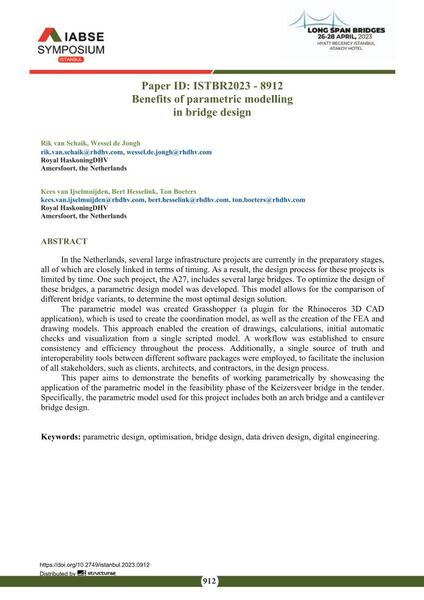Benefits of parametric modelling in bridge design

|
|
|||||||||||
Bibliographic Details
| Author(s): |
Rik van Schaik
(Royal HaskoningDHV, Amersfoort, the Netherlands)
Wessel de Jongh (Royal HaskoningDHV, Amersfoort, the Netherlands) Kees Van Ijselmuijden (HaskoningDHV, Amersfoort, the Netherlands) Bert Hesselink (HaskoningDHV, Amersfoort, the Netherlands) Ton Boeters (HaskoningDHV, Amersfoort, the Netherlands) |
||||
|---|---|---|---|---|---|
| Medium: | conference paper | ||||
| Language(s): | English | ||||
| Conference: | IABSE Symposium: Long Span Bridges, Istanbul, Turkey, 26-28 April 2023 | ||||
| Published in: | IABSE Symposium Istanbul 2023 | ||||
|
|||||
| Page(s): | 912-919 | ||||
| Total no. of pages: | 8 | ||||
| Year: | 2023 | ||||
| DOI: | 10.2749/istanbul.2023.0912 | ||||
| Abstract: |
In the Netherlands, several large infrastructure projects are currently in the preparatory stages, all of which are closely linked in terms of timing. As a result, the design process for these projects is limited by time. One such project, the A27, includes several large bridges. To optimize the design of these bridges, a parametric design model was developed. This model allows for the comparison of different bridge variants, to determine the most optimal design solution. The parametric model was created Grasshopper (a plugin for the Rhinoceros 3D CAD application), which is used to create the coordination model, as well as the creation of the FEA and drawing models. This approach enabled the creation of drawings, calculations, initial automatic checks and visualization from a single scripted model. A workflow was established to ensure consistency and efficiency throughout the process. Additionally, a single source of truth and interoperability tools between different software packages were employed, to facilitate the inclusion of all stakeholders, such as clients, architects, and contractors, in the design process. This paper aims to demonstrate the benefits of working parametrically by showcasing the application of the parametric model in the feasibility phase of the Keizersveer bridge in the tender. Specifically, the parametric model used for this project includes both an arch bridge and a cantilever bridge design. |
||||
| Keywords: |
parametric design bridge design optimisation data driven design digital engineering
|
||||
